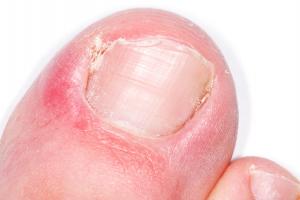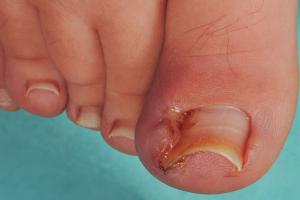Ingrown toenail
An ingrown toenail happens when the sides of the toenail grow into the surrounding skin. The nail curls and pierces the skin which becomes red, swollen and tender.
Symptoms of an ingrown toenail
The big toe is often affected by an ingrown toenail, either on one or both sides.

Other possible symptoms, as well as those above, include:
- pain if pressure is placed on the toe
- inflammation of the skin at the end of the toe
- a build-up of fluid in the area surrounding the toe
- an overgrowth of skin around the affected toe
- bleeding
- white or yellow pus coming from the affected area
When to see your GP
See your GP or podiatrist (foot care specialist) if your ingrown toenail is badly inflamed, bleeding or has pus coming from it, because it may be infected.

It's also important to get medical advice if you have diabetes and an ingrown toenail.
Having diabetes could affect how your toenail heals.
Causes of ingrown toenails
A number of things can cause an ingrown toenail to develop, including:
- badly cut toenails – cutting your toenails too short, or cutting the edges, will encourage the skin to fold over your nail and the nail to grow into the skin
- wearing tight-fitting shoes, socks or tights – this places pressure on the skin around your toenail; the skin may be pierced if it's pressed on to your toenail
- sweaty feet – if the skin around your toenails is soft, it's easier for your nail to pierce it and embed itself within it
- injury – for example, stubbing your toe can sometimes cause an ingrown toenail to develop
- natural shape of the nail – the sides of curved or fan-shaped toenails are more likely to press into the skin surrounding the nail
A fungal nail infection can cause your toenail to thicken or widen.
Treating ingrown toenails
Without treatment, an ingrown toenail can become infected, so it’s important that you:
- keep your feet clean by washing them regularly with soap and water
- change your socks regularly
- cut your toenails straight across to stop them digging into the surrounding skin
- gently push the skin away from the nail using a cotton bud (this may be easier after using a small amount of olive oil to soften the skin)
- wear comfortable shoes that fit properly
Surgery may be recommended if your toenail doesn't improve. Depending on the severity of your symptoms, this may involve either:
- partial nail avulsion – removing part of your toenail
- total nail avulsion – removing your whole toenail
Your podiatrist or GP can advise you whether this is necessary.
Preventing ingrown toenails
Taking care of your feet will help prevent foot problems such as ingrown toenails.
Tips for taking care of your feet
- it’s important to cut your toenails properly (straight across, not at an angle or down the edges)
- wash your feet every day, dry them thoroughly and use foot moisturiser
- you can also use a foot file or pumice stone to remove hard or dead skin
- wearing shoes that fit properly will help to make sure your feet stay healthy
- you should also change your socks (or tights) every day
Visit your GP or a podiatrist as soon as possible if you develop problems with your feet.
More useful links
The information on this page has been adapted from original content from the NHS website.
For further information see terms and conditions.